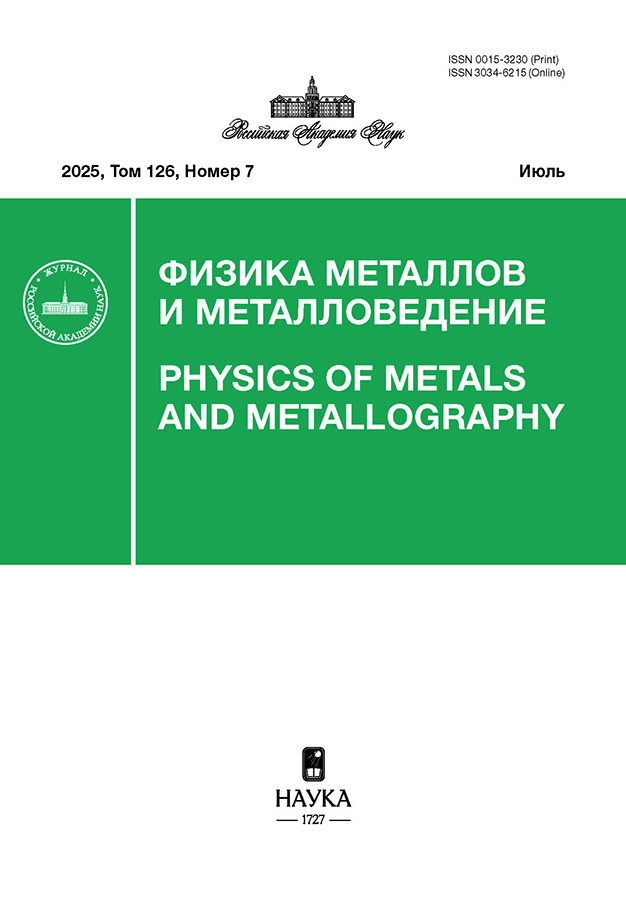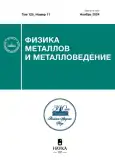Теплофизические свойства высокопрочной низколегированной трубной стали
- Авторы: Урцев Н.В.1,2,3, Платов С.И.3, Шмаков А.В.1, Рыжков М.А.2, Лобанов М.Л.2,4
-
Учреждения:
- ООО Исследовательско-технологический центр Аусферр
- УрФУ им. первого Президента России Б.Н. Ельцина
- ФГБОУ ВО Магнитогорский государственный технический университет им. Г.И. Носова
- Институт физики металлов УрО РАН
- Выпуск: Том 125, № 11 (2024)
- Страницы: 1452-1458
- Раздел: ПРОЧНОСТЬ И ПЛАСТИЧНОСТЬ
- URL: https://modernonco.orscience.ru/0015-3230/article/view/681762
- DOI: https://doi.org/10.31857/S0015323024110146
- EDN: https://elibrary.ru/ILSFVK
- ID: 681762
Цитировать
Полный текст
Аннотация
Контролируемая термомеханическая обработка (КТМО) низкоуглеродистых низколегированных трубных сталей используется для достижения требуемого уровня механических свойств трубного проката и, соответственно, для обеспечения стабильности и надежности эксплуатации магистральных трубопроводов. КТМО включает горячую деформацию аустенита и последующее ускоренное охлаждение, во время которого реализуется y→α-превращение. Оснащение современных толстолистовых станов позволяет разрабатывать и внедрять в металлургическое производство информационные системы управления структурой и, соответственно, свойствами стали. Уровень надежности и точности работы таких систем возможно повысить, используя корректные теплофизические параметры сталей. В настоящей работе методами дифференциальной сканирующей калориметрии, дилатометрического анализа и расчетами с использованием программного обеспечения Thermo-Calc определены критические температуры, температурные зависимости теплоемкостей основных фаз и значения тепловых эффектов фазовых превращений в образцах высокопрочной низколегированной трубной стали 05Г2МБ (в мас. % ~ 0.05 C; ≤ 2.0 Mn; ~ 0.2 Mo; ~ 0.05 Nb). Показано, что значение теплового эффекта магнитного превращения значительно превышает значение теплового эффекта полиморфного фазового превращения.
Полный текст
Об авторах
Н. В. Урцев
ООО Исследовательско-технологический центр Аусферр; УрФУ им. первого Президента России Б.Н. Ельцина; ФГБОУ ВО Магнитогорский государственный технический университет им. Г.И. Носова
Автор, ответственный за переписку.
Email: n.urtsev@ausferr.ru
Россия, ул. Ломоносова, 11/1, Магнитогорск, 455000; ул. Мира, 19, Екатеринбург, 620002; пр-т Ленина, 38, Магнитогорск, 455000
С. И. Платов
ФГБОУ ВО Магнитогорский государственный технический университет им. Г.И. Носова
Email: n.urtsev@ausferr.ru
Россия, пр-т Ленина, 38, Магнитогорск, 455000
А. В. Шмаков
ООО Исследовательско-технологический центр Аусферр
Email: n.urtsev@ausferr.ru
Россия, ул. Ломоносова, 11/1, Магнитогорск, 455000
М. А. Рыжков
УрФУ им. первого Президента России Б.Н. Ельцина
Email: n.urtsev@ausferr.ru
Россия, ул. Мира, 19, Екатеринбург, 620002
М. Л. Лобанов
УрФУ им. первого Президента России Б.Н. Ельцина; Институт физики металлов УрО РАН
Email: n.urtsev@ausferr.ru
Россия, ул. Мира, 19, Екатеринбург, 620002; ул. С. Ковалевской, 18, Екатеринбург, 620108
Список литературы
- Lobanov M.L., Zorina M.A., Karabanalov M.S., Urtsev N.V., Redikultsev A.A. Phase Transformation Crystallography in Pipeline HSLA Steel after TMCP // Metals. 2023. V. 13. № 6. P. 1121.
- Pumpyanskii D.A., Pyshmintsev I.Y., Lobanov M.L., Urtsev N.V., Denisov S.V., Urtsev V.N. Effect of Finish Rolling Temperature on the Texture and Fracture Resistance of Low-Carbon High-Strength Pipe Steels during Thermomechanical Treatment // Metal Sci. Heat Treatment. 2023. V. 65. № 5–6. P. 330–337.
- Petersen Cl., Corbett K., Fairchild D. Improving long-distance gas transmission economics. X120 development over-view / Proceedings of 4th International Pipeline Conference. Ostend. 2004. Р. 3–29.
- Столхейм Д. Дж. Современные схемы легирования и практика производства высокопрочных сталей для магистральных нефтегазопроводов. Часть I // Металлург. 2013. № 11. С. 53–66.
- Paravicini В.E., Anelli E., Paggi A., Cuonzo S.D. Development of heavy-wall seamless pipes with improved toughness and hardness control / 6-th International pipeline technology conference. Ostend, Belgium, 2013. Р. 3–13.
- Хулка К., Хайстеркамп Ф. Тенденции азработки сталей для труб большого диаметра // Сталь. 1997. № 10. С. 62–67.
- Morozov Yu.D., Nastich S.Yu., Matrosov M.Yu., Chevskaya O.N. Obtaining high-quality properties of rolled material for large-diameter pipes based on formation of ferrite-bainite microstructure // Metallurgist. 2008. V. 52. № 1–2. P. 21–28.
- Matrosov M.Yu., Kichkina A.A., Efimov A.A., Efron L.I., Bagmet O.A. Simulating structure-forming processes in tube steels during controlled rolling with accelerated cooling // Metallurgist. 2007. V. 51. № 7–8. P. 367–376.
- Nastich S.Y., Morozov Y.D., Matrosov M.Y., Denisov S.V., Galkin V.V., Stekanov P.A. Assimilation of production in an MMK 5000 mill of thick rolled sheet from low-alloy steels with improved strength and cold resistance properties // Metallurgist. 2012. V. 55. № 11–12. P. 810–818.
- Пышминцев И.Ю., Смирнов М.А. Структура и свойства сталей для магистральных трубопроводов. Екатеринбург: УМЦ УПИ, 2019. 242 с.
- Platov S.I., Gorbatyuk S.M., Lobanov M.L., Maslennikov K.B., Urtsev N.V., Dema R.R., Zvyagina E.Y. Mathematical Model of the Accelerated Cooling of Metal in Thick-Plate Hot Rolling // Metallurgist. 2022. V. 66. № 3–4. P. 462–468.
- Lobanov M.L., Khotinov V.A., Danilov S.V., Stepanov S.I., Urtsev V.N., Urtsev N.V., Platov S.I. Tensile Deformation and Fracture Behavior of API-5L X70 Line Pipe Steel // Materials. 2022. V. 15. № 2. P. 501.
- Gorbachev I.I., Korzunova E.I., Popov V.V., Khabibulin D.M., Urtsev N.V. Simulation of Austenite Grain Growth in Low-Alloyed Steels upon Austenitization // Phys. Met. Metal. 2023. V. 124. № 3. P. 290–295.
- Морозов Ю.Д., Матросов М.Ю., Арабей А.Б., Настич С.Ю. Высокопрочные трубные стали нового поколения с феррито — бейнитной структурой // Металлург. 2008. № 8. С. 39–42.
- Пышминцев И.Ю., Столяров В.И., Гервасьев А.М., Харитоновский В.В., Великоднев В.Я. Особенности структуры и свойств опытных партий труб категории прочности К65 (Х80), изготовленных для комплексных испытаний // Наука и техника в газовой промышленности. 2009. № 1. C. 56–61.
- Зельдович В.И., Хомская И.В., Фролова Н.Ю., Хейфец А.Э., Абдуллина Д.Н., Петухов Е.А., Смирнов Е.Б., Шорохов Е.В., Кленов А.И., Пильщиков А.А. Структура и механические свойства аустенитной нержавеющей стали, полученной методом селективного лазерного плавления // ФММ. 2021. Т. 122. № 5. С. 527–534.
- Агажанов А.Ш., Самошкин Д.А., Станкус С.В. Теплопроводность и температуропроводность железа в интервале температур 300–1700 K // ФММ. 2023. Т. 124. № 12. С. 1149–1158.
- Massalski T.B., Joanne L.M., Bennett L.H., Baker H. Binary alloy phase diagrams. Ohio: ASM, 1986. 2224 p.
- Лившиц Б.Г., Крапошин В.С. Физические свойства металлов и сплавов. М.: МАШГИЗ, 1953. 352 с.
- Геллер Ю.А., Рахштадт А.Г. Материаловедение: Методы анализа, лабораторные работы и задачи. Учебное пособие для вузов. М.: Металлургия, 1989. 456 с.
- Лобанов М.Л., Платов С.И., Зорина М.А., Урцев Н.В., Масленников К.Б. Влияние режимов контролируемой термомеханической обработки на структурно-текстурные состояния низкоуглеродистой низколегированной стали // Металловедение и термич. обр. металлов. 2023. № 8(818). С. 27–35.
- ASTM E1269–11 (2018). Standard Test Method for Determining Specific Heat Capacity by Differential Scanning Calorimetry. ASTM International, 2018. 6 p.
- ASTM A1033–18. Standard Practice for Quantitative Measurement and Reporting of Hypoeutectoid Carbon and Low-Alloy Steel Phase Transformations. ASTM International, 2018. 14 p.
- Романов П.В., Радченко В.П. Превращение аустенита при непрерывном охлаждении стали: Атлас термокинетических диаграмм. Ч. 1. Новосибирск: Изд-во Сиб. отд. АН СССР, 1960. 51 с.
Дополнительные файлы











